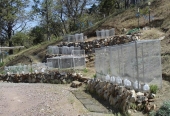I can only say what I would try, some of these things might not work for you.
For starches, I think wild animals especially wild hogs would dig up potatoes faster than they could grow, it could still be worth trying. I would turn to a wild plant though- Cattails- the roots are very high in starch, just dig them up, peel off the outer layer and cook. The tops of the plants especially when young are good tasty greens. You mentioned that there is three springs so I am assuming there are some creeks and ponds around.
Rhubarb is very tough and seems to grow anywhere, so it could be planted and left, no problem.
I wonder if asparagus would work. In the garden it needs added nutrients in the form of
compost or other fertilizers, but this is because the tops get chopped off every couple days for four to six weeks before it is allowed to grow to a full sized plant. It might not need the extra care if it is not being harvested regularly. It might be worth a try if you like asparagus.
I would try to plant foods specifically for the wild critters, in case you ever need them for the protein, it will be much easier to hunt if they are used to coming to the cabin for food.
It might be worth the effort to plant apple trees, no yield for a few years, but if the deer don't eat them down before they can get well established. They will produce food for you when you need it. When you don't pick them the wild animals will quickly learn to come and eat fallen apples. This will bring them in close right in the middle of hunting season, also animals eating lots of fallen apples will have very tasty meat.
Bushes like wild raspberries and rose hips produce some food and should grow fine in a forest without any care. They will not produce as much without care but some is better than none. If this is a mostly coniferous forest blueberries might grow well.
In a natural forest in my area I can always look around and spot at least two different edible wild plants at any time. I don't know what a Tennessee forest looks like though, so I would not do so well there. I would suggest learning about the wild edibles you can find there, and then encouraging their growth and planting even more.
There are a lot of plants that are considered weeds that are actually great food, like dandelion, and stinging nettles. For dandelion cook up the roots, for stinging nettle cook the leaves. There are lots more, you just have to identify the plant and then google it or find a good book to tell you what it is good for.
Depending on what type of trees are there, some might produce edibles already. Oaks produce acorns which are edible after some processing, some pines produce edible seeds.
I hope some of these ideas help you.
Leora





